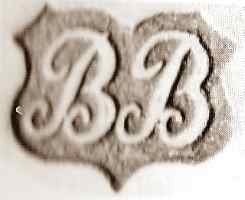YOUR GUIDE TO MARCH NEWSLETTER:
articles
new members
members' window
mail to ASCAS
replies to questions
a page per month
a silversmith per month
a word per month
a book on my shelf
a crest per month
contributors to this Newsletter
search engine
disclaimer and privacy policy
A new article for
ASCAS website
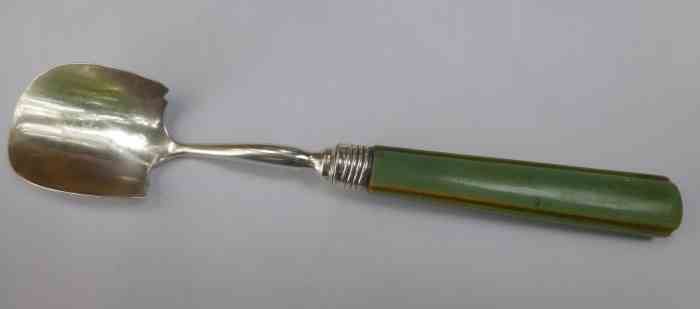
Jolyon Warwick James presents:
The Eleven O' Clock Club

Despite its name the eleven o'clock club actually meets at 10.30 am in a pub in Portobello Road. It is not a formal "club" at all but an informal group of like-minded collectors,
enthusiasts and academics who meet for tea, coffee (not alcohol) and an exchange of ideas and oddities in silver plus a show and tell of the morning's purchases. On Saturday 27th June, seven people filled
the table with tea pots, cups, saucers, sugar sachets, silver, and a cacophony of debates.
A particularly interesting conundrum was tabled by Tony Dove, a luminary and veteran of these meetings. May I immediately apologise for any deficiency in the photography. It was undertaken under difficult
circumstances - a pocket camera, a crowded table littered with half full cups, busily criss-crossed by silver objects and competing discussions. The plain reverse of an A4 sheet (listing the Silver Spoon
club's spoon auction results on the other side) was pressed into service as a photographic backcloth....
click
here

New members
Welcome to new ASCAS members:
Leona Ambuldeniya - Canada
Elizabeth Koble - USA
Patrizia Comerci - Italy
Members' Window # 110

Alan Yates presents:
An unusual pseudo mark

Most members will, I suspect, be familiar with the term ‘pseudo marks’ and may have encountered pieces of silver with such marks. Very briefly, a pseudo mark is a false or
counterfeit mark. Some are particularly sophisticated, others less so. I collect colonial silver and have seen numerous examples and indeed purchased some pieces because I find
them of interest provided the seller values the item accordingly, i.e. at a lower value than the identical item with a genuine hallmark. In my experience, I have seen more on
Chinese export silver than any other category of silver. Most pseudo marks are intended to mislead the buyer that the item is English on the basis of an array of alphabetic letters,
lions passant, and crown or leopard’s heads, etc.....
click here

|
Mail to ASCAS:
e-mail
silverassociation@yahoo.it
Neal Trzebiatowski writes:
... I came across an antique presentation cup of some sort that I have, but cannot identify the maker, or other information from the hallmark.
I was wondering if you've ever seen this Mark, or can decipher it.
Thank you
Neal Trzebiatowski
Alan Yates writes:
... It might be interesting to canvass the attitude of the members towards inscriptions on a piece of silver.. My thoughts are briefly as follows:
I do not like an object that has had an inscription erased; very unfortunate and prejudices its value, but it still may be worth acquiring depending on all the other usual considerations.
If it is a well done inscription, and with of historic or political interest together with a date, in my opinion the value is enhanced. If it is a gift from an anonymous Bert to Emma, in
my opinion I’d rather have no inscription, but I would never contemplate its erasure.
The object in the image attached is a small glass coaster on three small bracket feet approx. 9 cm diameter. It commemorates the win in class 3 of the 1973 Cape to Rio yacht race and all the crew members probably
received one each in addition to a trophy awarded to the skipper of the boat. Unfortunately, in my opinion, it does not show the name of the yacht.
It is well made and a good weight.
Logically it would be Brazilian silver but I am not familiar with any South American marks. It is well marked and I hope someone in the association can enlighten me.
I bought it in Cape Town about ten years ago.
Alan Yates
Alan Johnson writes:
... I hope you can help me identify the maker and date of a teapot I bought recently.
It would appear to be the initials M & S, what appears to be a beaver, the letter S in a shield cartouche and finally the letter A1.
Thanking you in anticipation
Alan Johnson
Mrs G. Brown writes:
... I am hoping you can help me to identify the markings on this toast rack. I have looked endlessly on the internet your site showing silver marks but so many look the same
to me that I am trying to get a more accurate time, etc.
Thank you in advance for any help you can give me.
Mrs G. Brown
"A PAGE per MONTH"
In this column we presents a page obtained from makers'
brochures, books, auction catalogs, advertising or whatever
other printed paper, related to silver, that may be of interest
for ASCAS members.
The images will be published at a "low resolution" level and for
private and personal use only.
This column is published under the kind permission of Giorgio
Busetto's website

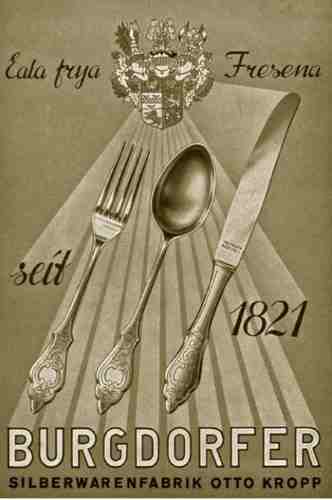 |
This month ASCAS presents a c. 1971 advertisement of:
BURGDORFER SILBERWARENFABRIK OTTO KROPP
A firm founded by Gustav Haegermann in 1821 and still active in Schillelager Str. 3, Burgdorf (Germany). This advertisement was used in c. 1971 to celebrate the 150th anniversary of the foundation.
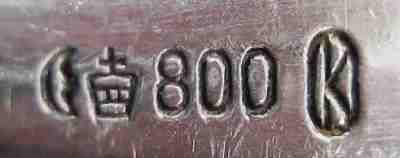

ADVERTISEMENTS IN SILVER - SILVER ADVERTISING
section of www.silvercollection.it website
|
"A WORD per MONTH"
In this column we
present an abstract from a page of the "What is? Silver
Dictionary"
courtesy of






|
"CROWN" MARK
ON STERLING SILVER AND SILVERPLATE
From the very beginning the platers tried to make their wares resemble silver as closely as possible. It did no harm if the marks on them also looked rather like those on silver.
Since the early times Old Sheffield Plate presents initials and symbols in the same style and on the same places as did the silversmiths, sometimes repeating these devices to simulate the stamp of the assay
office, the lion and the maker's mark.
When in 1773 the silversmiths of Sheffield and Birmingham obtained to establish assay offices for silverwork in both towns, the "crown" symbol was chosen to identify Sheffield Assay Office
(the "anchor" was chosen for Birmingham).
One of the objective of the established Assay Office in Sheffield was to obtain some degree of control over the platers as the Parliament Act carried a clause prohibiting the striking of any letter,
or letters, on goods "Made of metal, plated or covered with silver, or upon any metal vessel or other thing made to look like silver: the penalty being a fine of £ 100"....
more
|
"A SILVERSMITH per MONTH"
|
|
BARNABUS BLACKBURN
BLACKBURN & RASMUSSEN
Barnabus (or Barnabas) Blackburn was active in London as silversmith and electroplater at 4 Leicester Place (1875-1881), at 49 Rupert Street (1882-1890), at 15
Rupert Street (1890-1916) at 9 Orange Street, Haymarket (1916-1928) and 95 Dean Street, Oxford Street from 1928 to 1933, when he went out of business......
more
|
"A CREST per MONTH"
FROST OF DOLCORSLLWYN
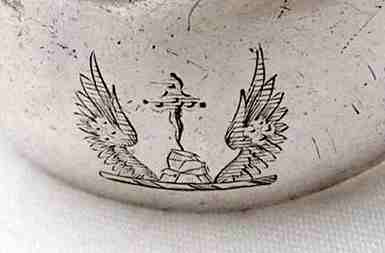
|
Upon a rock proper between two wings azure, each charged with a quatrefoil argent, a trefoil slipped azure (information courtesy Charles C. Cage)
The crest of Frost of Dolcorsllwyn
The crest was found on a silverplate tea tongs made by James Dixon & Sons
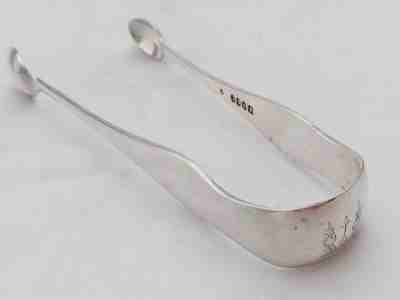
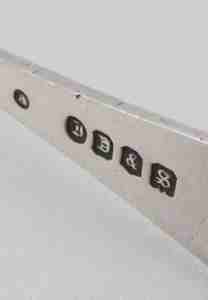
|
Closing our MARCH 2016 edition of ASCAS Newsletter I hope
you have appreciated its content.
Your comments, suggestions and advice will be of great help.
My thanks to G. Brown, Jolyon Warwick James, Alan Johnson, Neal Trzebiatowski and Alan Yates for their precious contributions.
Giorgio Busetto
Secretary
DISCLAIMER AND PRIVACY POLICY
ASCAS is a community of people having a common
interest in antique silver.
It is a non-profit association without commercial links.
Membership is open to whomever has a true interest in
this subject matter.
ASCAS has no real property and no fees are requested nor
accepted from members.
ASCAS keeps in touch with its members only through
periodical newsletters, e-mails and web-site updating
and ignores and is not responsible for any other
activity pursued by its members.
Likewise, ASCAS is not responsible for opinions,
evaluation and images displayed, and in any form
published or supplied for publication, by its members
who, in any case, maintain the property of their works
and assure the respect of national and international
legislation about Intellectual Property.
ASCAS does not have the full addresses of its members (only
town, country and e-mail address are requested for
membership).
ASCAS handles and protects with care its members' e-mail
addresses, will not disclose the addresses to third
parties, will use this information only to reply to
requests received from members and for communications
strictly related to its activity.
These rules are expressly accepted by submitting the
membership request.
|
|
 newsletter
# 142 March 2016
newsletter
# 142 March 2016





















